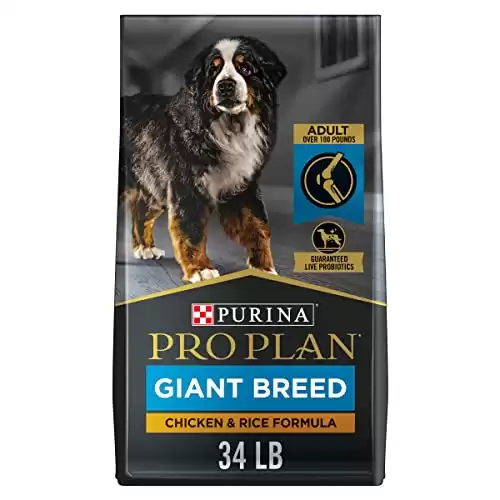Saint Bernard
Canis lupus
Saint Bernard dogs have a slow progression into mental adulthood, maintaining their puppy-like tendencies for years longer than other breeds.
Advertisement
Saint Bernard Scientific Classification
- Kingdom
- Animalia
- Phylum
- Chordata
- Class
- Mammalia
- Order
- Carnivora
- Family
- Canidae
- Genus
- Canis
- Scientific Name
- Canis lupus
Read our Complete Guide to Classification of Animals.
Saint Bernard Conservation Status
Saint Bernard Facts
- Fun Fact
- Saint Bernard dogs have a slow progression into mental adulthood, maintaining their puppy-like tendencies for years longer than other breeds.
- Temperament
- Intelligent, friendly, loyal
- Diet
- Omnivore
Saint Bernard as a Pet:
- General Health
- Energy Level
- Shedability
- Trainability
- Intelligence
- Tendency to Chew
- Size
- Family and kid friendliness
- Yappiness / Barking
- Low
- Separation Anxiety
- Low
- Preferred Temperature
- Cold climate
- Exercise Needs
- Low
- Friendly With Other Dogs
- Moderate
- Pure bred cost to own
- $1,500 (average)
- Dog group
- Working
- Male weight
- 140-180 lbs
- Female weight
- 120-140 lbs
This post may contain affiliate links to our partners like Chewy, Amazon, and others. Purchasing through these helps us further the A-Z Animals mission to educate about the world's species.
View all of the Saint Bernard images!
Key Facts
- Saint Bernards don’t do too well in tropical weather and are best kept in regions with a cooler climate.
- They may either have a short-haired coat or a long-haired coat.
- In spite of their history as working dogs, they are none too fond of exercise.
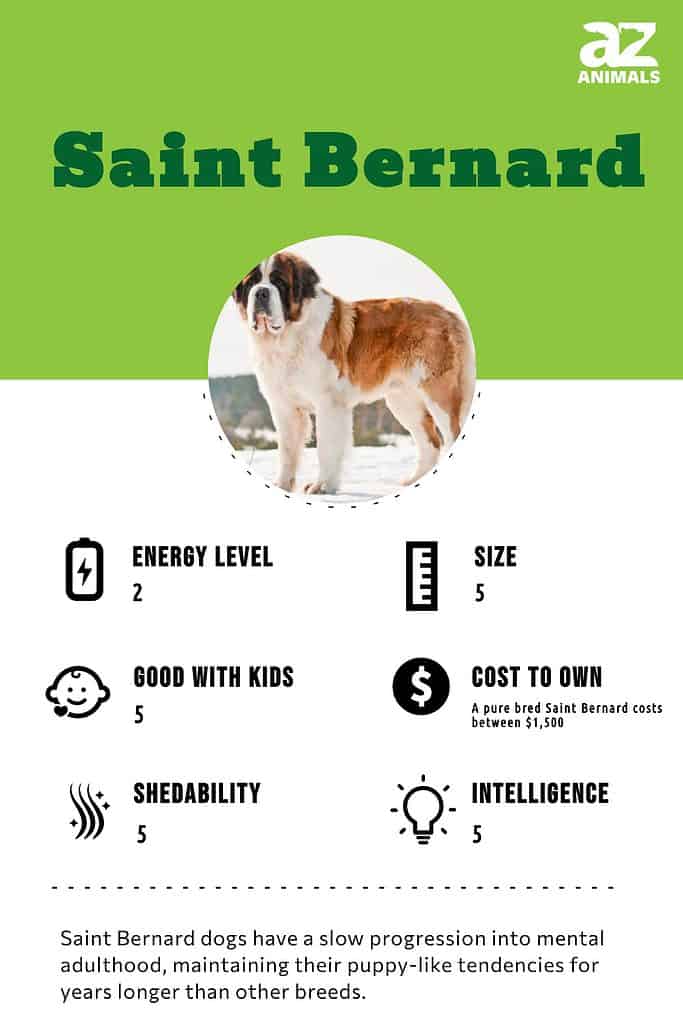
Originally, the Saint Bernard was bred as a working dog in the Alps. Though they no longer have to work in this weather, their coats are just as thick, and their body offers just as much muscle.
Saint Bernard dogs are large and extraordinarily muscular working dogs originating from the Western Alps in Italy and Switzerland. While highly intelligent adults, Saint Bernard puppies are known to mentally mature more slowly than other breeds. Often drooling and tracking mud into the house, this breed may be a rather messy pet. Saint Bernards have thick coats adjusted to cold weather and do not do well in hot climates, shedding immensely.
See all of our expert product reviews.
3 Pros and Cons of Owning a Saint Bernard
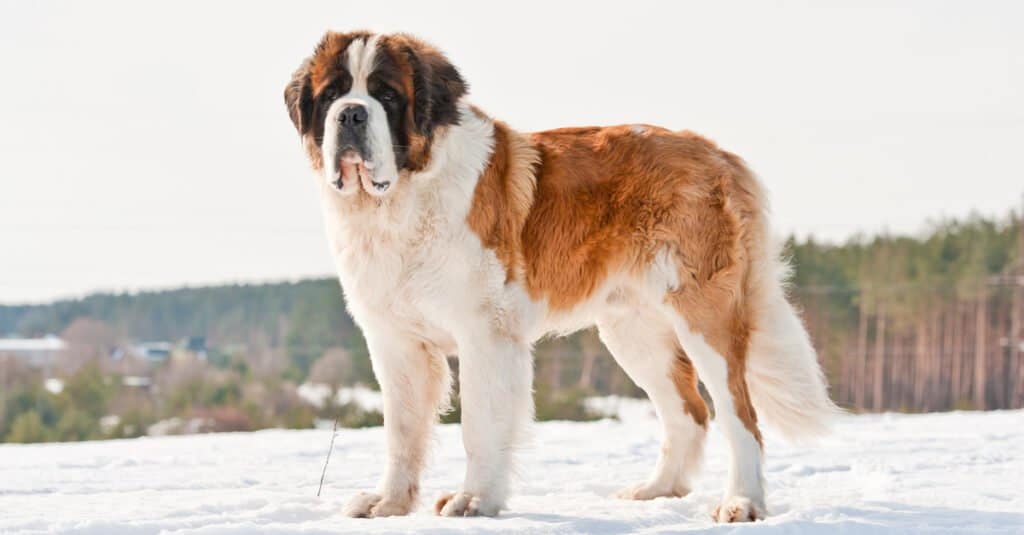
Saint Bernards are friendly and clever. That said, they are not exactly known for being especially clean
©Rita_Kochmarjova/Shutterstock.com
| Pros! | Cons! |
|---|---|
| Intelligence: If you are looking for a witty and intelligent dog breed, this might be a good choice. These dogs are quick learners. | Lazy: Most Saint Bernard dogs are not active and require a lot of push for exercise. |
| Friendly: Saint Bernard dogs are usually happy-go-lucky and can gel well with people. | Big size: If you are looking for a compact, small-size pet, this might not be the one for you as a Saint Bernard is very large and can easily reach all tables. |
| Great watchdogs: These dogs may be friendly with their family, but their large size and alertness can mean trouble for burglars. | Messy: Cleanliness is not a Saint Bernard’s forte. They drool often and get their paws dirty in the mud, in turn ruining the house interiors. These dogs also shed a lot. |
Size and Weight
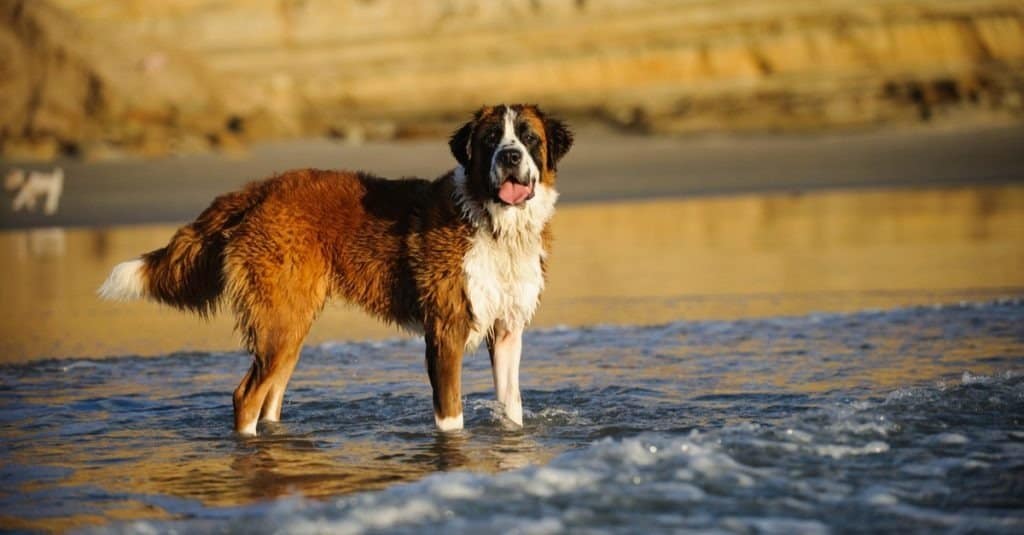
Saint Bernards are capable of reaching up to 200lbs
©everydoghasastory/Shutterstock.com
Health and Entertainment for your Saint Bernard
See all of our expert product reviews.
The Saint Bernard is a large dog, both in weight and height. The female dogs are about 26 to 28 inches as adults, while the males are 28 to 30 inches.
That frame is supported with a rather hefty weight. Females can get as large as 140 lbs., though the males will go even higher to 180 pounds.
| Height (Male) | 28” to 30” tall |
| Height (Female) | 26” to 28” tall |
| Weight (male) | 140 to 180 lbs., fully grown |
| Weight (female) | 120 to 140 lbs., fully grown |
Common Health Issues
All dog breeds are prone to health issues, Saint Bernards included. In particular, this breed is prone to hip and elbow dysplasia, caused by abnormal growth of the bones in the sockets. Osteosarcoma, a type of bone cancer, most often impacts the legs of Saint Bernards, though any bone can be affected.
Addison’s disease is another common occurrence in this breed, a condition that affects the adrenal glands and prevents the body from producing hormones correctly. Veterinarians say that most canines suffering from Addison’s will only live to be 4 years old. Common symptoms are non-specific, ranging from weight loss to vomiting to increased urine output.
Dilated cardiomyopathy can be another major concern for these dogs. Hereditary or acquired, this heart condition leads to decreased ability for the heart to pump blood to the body, leading to heart failure. Cardiac tissue thins out but still grows in size, therefore preventing blood flow. Symptoms may include fainting, difficulty breathing, fluid in the abdomen, etc.
Here is a list of the common health issues that these dogs suffer from:
- Hip Dysplasia
- Elbow Dysplasia
- Osteosarcoma
- Addison’s disease
- Eye problems
- Immunity problems
- Dilated cardiomyopathy
Temperament

Saint Bernards make excellent family pets but are not ideal for small children
©Katrina Brown/Shutterstock.com
The temperament of a Saint Bernard, much like the name suggests, is saint-like. Calm and gentle, this breed is known to be very patient and rarely aggressive around strangers. However, most people are scared of these dogs because of their looming stature.
Saint Bernards make excellent family dogs; however, careful consideration is required if a family has small children, as the gentle giant may accidentally harm a small infant.
While originally bred to work, Saint Bernards are somewhat lazy dogs, needing a push when it’s time for exercise. Most of the work this breed participates in now is therapy work, uplifting people’s moods with their relaxed demeanor, loving looks, and cuddly fur.
How to Take Care of a Saint Bernard
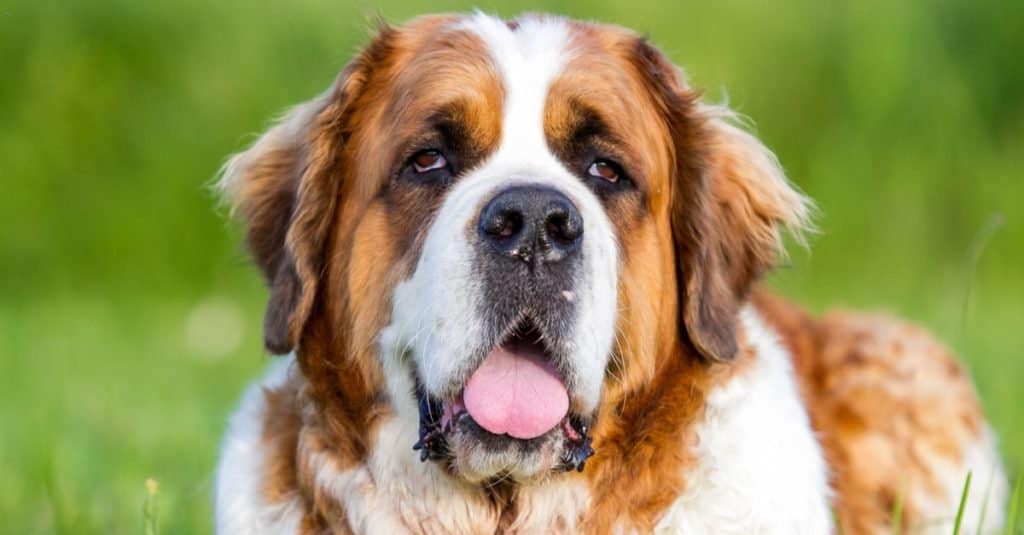
Saint Bernards’ aversion to activity and health issues mean they require a great deal of care
©Aneta Jungerova/Shutterstock.com
No two dogs are alike, each having a specific set of requirements to stay healthy and happy. Saint Bernards require an elevated level of care, considering their disdain for exercise and considerable health concerns. Here are a few things to know about taking care of this breed.
The Best Dog Food for Saint Bernards
The right canine diet will supply these giant furballs with the specific nutrients necessary for life. Balancing protein, fat, carbohydrates, minerals, and vitamins is essential when considering which dog food to choose to feed your pet. Dogs are omnivorous, making it possible to meet these dietary needs through plant and animal sources. Dogs should never be fed an all-meat diet, as it would lead to an imbalance in nutrients, while they are able to thrive off of an all-plant diet. Quality and digestibility of food are key when choosing which dog food to feed your dog. Saint Bernards should eat dog food made specifically for large breeds and one that supports bone and joint health may be beneficial in warding off related health issues.
As for the amount to feed a Saint Bernard, it is advised to feed about five to six cups of high-quality food, carting based on brand and content. However, it is important to divide meals into two or three servings a day, keeping metabolism stimulated and preventing unnecessary weight gain.
To stave off bone and joint deterioration, immune or heart issues, your Saint Bernard will thank you for Purina Pro Plan Large Breed & Giant Breed Chicken & Rice Adult Dry Dog Food & Wet Dog Food.
This breed is exclusively formulated for large and giant dogs like your Saint Bernard. So you can be sure it offers all the critical glucosamine for pain-free joints and calcium for strong bones. The Vitamin B1 and thiamine it contains, support that big heart, while its taurine is good for the eyes, immune system, and heart. Plus, the antioxidants and fatty acids can be an immune boost for Saint Bernards.
Find Purina Pro Plan Large and Giant Breed on amazon.
- Chicken & Rice dry kibble dog food for large breeds
- Contains Glucosamine and EPA for joint health
- Live probiotics for digestive and immune health
- 34lb bag
Maintenance and Grooming
Saint Bernards are found as having either a short-haired coat or a long-haired coat. The former are smooth with dense fur, while the latter offer a soft wave, designed for colder weather.
The coloration of their coats is highly distinguishable, featuring a rich ginger-red with white or white with ginger-red, and black accenting their facial structure. Both coat types shed heavily during the spring and fall seasons and regular grooming is recommended. Ultimately, it may be beneficial to brush your dog thoroughly a couple of times per week to remove any loose hair, helping to keep shedding under control.
Apart from regular brushing, Saint Bernards have heavy ears, prone to ear infections. Always keep an eye out for head shaking or head tilting, common signs of ear issues, and clean your dog’s ears when necessary. Nail maintenance is also important when owning a dog, keeping them short and healthy. Dogs do self-groom, so bathing is only necessary after a good romp in the mud or hardcore play session. To keep their mouths clean, wipe away any excess drool or left over food particles. Lastly, to maintain healthy dental hygiene, brush your dog’s teeth every other day with dog-safe toothpaste, keeping their breath smelling fresh and decreasing the chances of gum disease in the future.
Training
Large and somewhat stubborn, it is important to begin training your Saint Bernard puppy as early as possible so they adapt quickly. While these puppies tend to mature more slowly than other breeds, Saint Bernard’s are highly intelligent and meant to be trained for working purposes, so they are highly trainable. Make sure to include socialization with other dogs and people into your training regimen. Positive reinforcement and treat rewards are beneficial to making training fun and successful!
Exercise
Large and in charge, Saint Bernards do not actually require a whole lot of exercise. So, if you are looking for a jogging buddy, you may want to look into another breed, as Saint Bernards are often resistant to exercising at all. A short, daily walk should suffice for this breed.
Puppies

Like most breeds in general, it is best to start training Saint Bernards as puppies
©Katrina Brown/Shutterstock.com
Saint Bernard puppies are to be taken care of much in the same way as you would take care of an adult Saint Bernard. However, they are fed less and meals are broken down into 4-6 smaller meals, as they do not eat a lot at once. Smaller meals help with the digestive process to avoid vomiting or overindulging.
It is always a good idea to start training your Saint Bernard when he/she is still a puppy, especially with this breed. This foundation establishes good habits for easier training as the dog ages.
Children
Even though this is a very friendly dog and is considered to do very well with children, adopting them when you have small children at home is not recommended. Although they are loving and calm, they are large in size and can accidentally hurt your toddlers.
Similar Dogs
- Greater Swiss Mountain Dog: Just like the Saint Bernard, this canine is also loyal and friendly and has a protective nature towards the owner’s family. The Greater Swiss Mountain Dog has a predominantly black coat, and it was bred as a herding dog.
- Bernese Mountain Dog: These dogs are friendly and hardworking, and their lineage can be traced back 2000 years. They are very loyal to the families that they live with, and they have a fairly similar coloring to that of the Greater Swiss Mountain Dog.
- Entlebucher Mountain Dog: These dogs are strong and alert and have been known as “laughing dogs.” They were originally bred to move cattle and are known to be diligent workers.
Famous St. Bernard Dogs
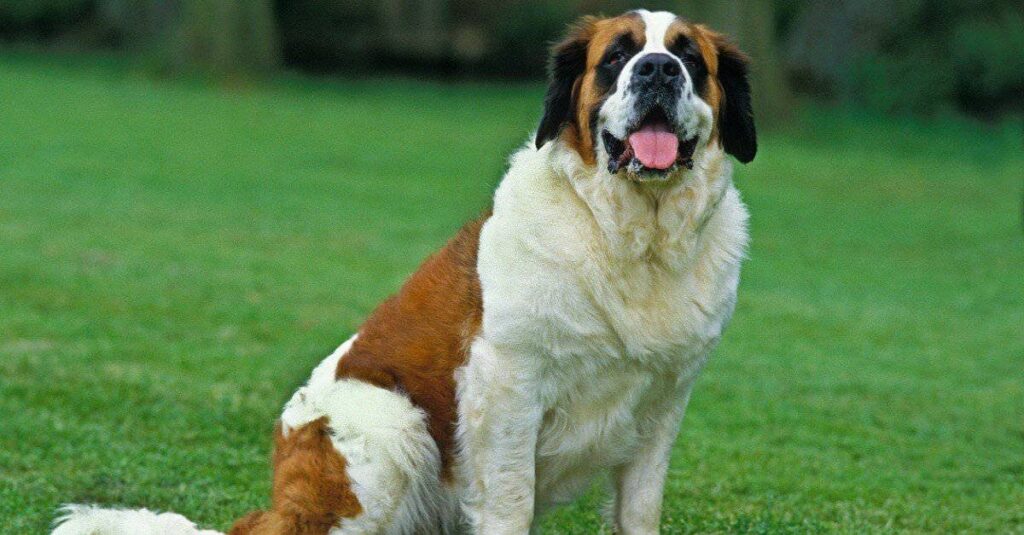
The St. Bernard is a massive dog, with a huge head, extremely muscular neck, and a deep chest.
©iStock.com/slowmotiongli
Probably the most notable Saint Bernard was the lead dog in the 1992 comedy, Beethoven. Wandering into an unsuspecting home, a Saint Bernard puppy, eventually named Beethoven, ends up as the hero of the movie, saving the daughter’s life. Many spin-offs were made because of the adoration millions had for Beethoven the Saint Bernard.
Another, more morbidly known Saint Bernard was Stephen King’s Cujo. Unfortunately, this friendly canine contracts rabies and terrorises people all over the town.
Popular Names for the St. Bernard
Here are some popular names for your Saint Bernard:
- Austin
- Beasty
- Aero
- Baxter
- Anna
Saint Bernard FAQs (Frequently Asked Questions)
Are Saint Bernards herbivores, carnivores, or omnivores?
Saint Bernards are Omnivores, meaning they eat both plants and other animals.
What Kingdom do Saint Bernards belong to?
Saint Bernards belong to the Kingdom Animalia.
What class do Saint Bernards belong to?
Saint Bernards belong to the class Mammalia.
What phylum to Saint Bernards belong to?
Saint Bernards belong to the phylum Chordata.
What family do Saint Bernards belong to?
Saint Bernards belong to the family Canidae.
What order do Saint Bernards belong to?
Saint Bernards belong to the order Carnivora.
What type of covering do Saint Bernards have?
Saint Bernards are covered in Hair.
What genus do Saint Bernards belong to?
Saint Bernards belong to the genus Canis.
How much does a Saint Bernard cost?
The price of a Saint Bernard is usually $1,500. You could expect an additional price of about $2,000 annually for the maintenance of a Saint Bernard.
How big does a Saint Bernard get?
Female Saint Bernard dogs are usually 26 to 28 inches, while the males are usually 28 to 30 inches in size.
How much does a Saint Bernard weigh?
Females weigh around 120 to 140 lbs., while the males weigh around 140 to 180 lbs.
Is the Saint Bernard dangerous?
The Saint Bernard is not usually aggressive. People are usually scared of them due to their large size.
Is the Saint Bernard protective?
The Saint Bernard is typically protective of their family. They are incredibly loyal and make helpful watchdogs.
Is the Saint Bernard good with kids?
Yes, the Saint Bernard is known to be great with kids. However, they don’t always understand how large their size is, so they may pose a risk to smaller children.
How long does a Saint Bernard live?
The lifespan of a Saint Bernard is usually 8 to 10 years.
What is an interesting fact about Saint Bernards?
Saint Bernards are gentle, loyal, and friendly!
What is the scientific name for the Saint Bernard?
The scientific name for the Saint Bernard is Canis lupus.
What's the difference between a St. Bernard and a Bernese Mountain Dog ?
The key differences between Saint Bernard and the Bernese Mountain Dog (a.k.a. Berner) are size, appearance, lifespan, origin, and temperament.
Saint Bernards are frequently larger and heavier than Bernese mountain dogs. Additionally, while Saint Bernard and Bernese mountain dogs are related, their origin is distinct. For instance, Saint Bernard originated in the Western Alps of Italy and Switzerland, but the Berner originated in the Berne region of Switzerland.
What's the difference between a Saint Bernard and a Newfoundland?
The main difference between a Saint Bernard and a Newfoundland is that the Saint Bernard grows slightly larger on average. These dogs were also bred for different purposes originally, though they both make fantastic watch dogs and rescue dogs.
What is the key difference between Great Pyrenees and St Bernard?
The key difference between the Great Pyrenees and St. Bernard is their health. Other differences include size, coat, lifespan, temperament, and drooling frequency.
What is the key difference between Great Dane and St Bernard?
The key difference between a St. Bernard and a Great Dane is appearance. Other differences include size, lifespan, temperament, energy level, grooming requirements, drooling, and barking.
What is the key difference between Mastiff and St Bernard?
The key difference between a Mastiff and a St. Bernard is size. Mastiffs can weigh up to 50 pounds more than St. Bernards. Other differences include appearance, lifespan, grooming needs, and drooling level.
Thank you for reading! Have some feedback for us? Contact the AZ Animals editorial team.
Sources
- Dogtime / Accessed January 18, 2021
- Mental Floss / Accessed January 18, 2021
- Colorado Saint Bernard Rescue / Accessed January 18, 2021
- Vetstreet / Accessed January 18, 2021
- Dog Lover's Digest / Accessed January 18, 2021
- Dogtopia / Accessed January 18, 2021
- My Dog's Name / Accessed January 18, 2021






